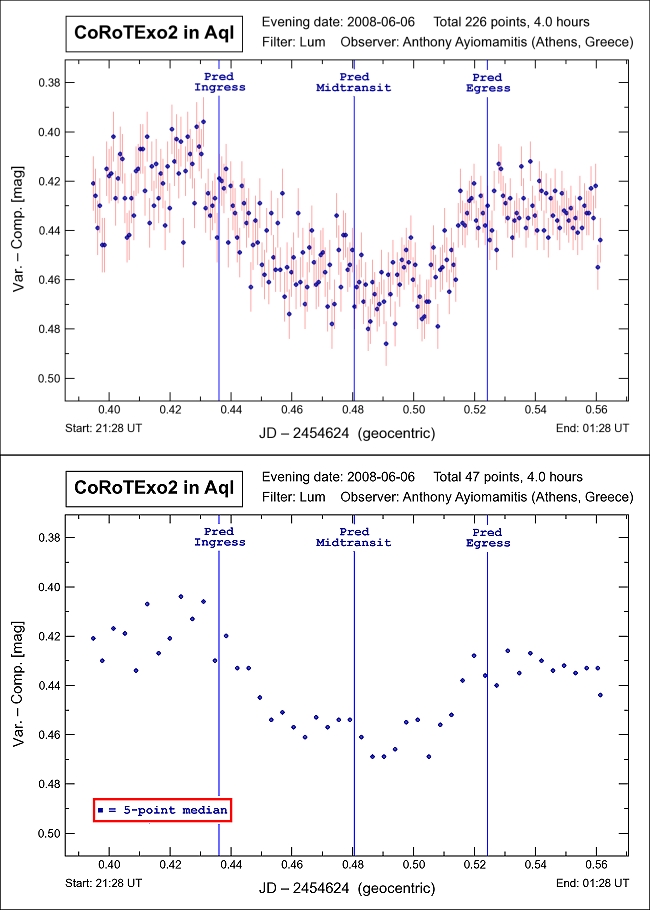
A variable star, as its name suggests, is a star whose magnitude varies intrinsically, in contrast to eclipsing binaries
whose magnitude varies as a result of one star in the binary system eclipsing the other. True variables are one of five
types, namely Mira stars, semiregular stars, cepheids, eruptive variables and, finally, cataclysmic variables. Minimum to
maximum magnitude can range from days to many months with some variables displaying irregular periods.
A popular method for the study of variable stars, particularly short-term variables, is by the use of the technique known
as "differential photometry". Rather than measure the (variable) magnitude of a variable star on an absolute scale,
measurements are made over time relative to one or more non-variable star(s) and these differences are then plotted so as
to study and illustrate the relative or differential change in magnitude. Due to the very large number of variables stars,
the field of differential photometry represents one of the key fields in astronomy whereby the amateur astronomer can make
a meaningful and long-lasting contribution to both science and astronomy.
More recently, the search for extrasolar planets (275 discovered so far) has identified yet another interesting application
for the practice of differential photometry whereby the minute drops in magnitude of a star hosting an exoplanet are studied.
Further details for the interested party are available here.
Note: The light curve for exoplanet CoRoT-2b in Aquilla depicted below is the second discovery
of the French-led CoRoT (Convection Rotation and planetary Transits) satellite mission which was launched in December 2006
for the specific purpose of studying 12,000 stars per session over 30- and 150-day periods using an on-board 27-cm telescope.
Its main advantage being in (polar) earth orbit is the ability to bypass the adverse effects of earth's atmosphere and the
limited windows of opportunity available otherwise (due to darkness etc). CoRoT-2b, announced in the spring of 2008, is
characterized with a mass and radius 3.31 and 1.465 times that of Jupiter, respectively, thus making this find one of the
most extreme exoplanets discovered so far and which defies current irradiated planet theory and modelling since its radius
is much bigger for its mass. CoRoT-2b requires 125.3 minutes to transit its parent star at a depth of approximately 3.01%.
The parent star, GSC 465:1282, is estimated to have a mass of 0.97 solar masses, a radius equivalent to 0.902 solar radii,
a temperature of 5,625° K and to lie at a distance of 930 light-years away with a visual magnitude of 12.57. Further details
regarding CoRoT-2 and CoRoT-2b are available in the paper published by the discovery team led by Roi Alonso et al (click
here).
Note: The C- and K-stars used for the purposes of the differential photometry measurements
depicted below were GSC 465:453 (mag 12.60) and GSC 465:325 (mag 12.60) respectively. The light curve below is the
first amateur result of this newly discovered exoplanet in the constellation of Aquilla.
|
Parent Star: CoRoT-2 GSC/SAO Catalog: GSC 465:1282 Constellation: Aquilla RA / Dec: 19h 27m 07s / +01° 23' 02" Magnitude: 12.57 Distance: 930 light-years Exoplanet: CoRoT-2b Period: 1.7429964 + 0.0000017 d Transit Duration: 125.3 mins Transit Depth: 30.1 mmag Minimum Mass: 3.31 MJup Radius: 1.465 RJup Pred Transit Details:
|
 |
Date: June 6-7, 2008 00:28:01 - 04:28:50 UT+3 Location: Athens, Greece Equipment: AP 160 f/7.5 Starfire EDF AP 1200GTO GEM SBIG ST-2000XM SBIG CFW-10 SBIG LRGB + IR-block Integrations:
Temperatures:
Software: CCDSoft V5.00.188 AIP4Win V2.2 Processing: Reduction Differential Photometry |